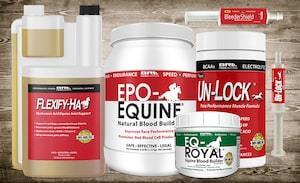
How much time do you spend cleaning stalls? Do you think there's room for improvement? If so, we’ve got you covered. The following tips may be easier on your wallet and can free up some much-deserved riding time!
Why Daily Cleaning Matters
When you skip days, don’t clean stalls properly or skimp on bedding, you put your horse at higher risk for health problems. Dirty stalls attract insects, bacteria and mold/mildew, which in turn can lead to illnesses like thrush (a fungal infection) or allergies.
So rather skipping or skimping on stall cleaning, how about finding more efficient ways to get your stalls in ship-shape?
Use a Bedding Fork
1. Use a good, lightweight manure fork that can double as a bedding fork. Without enough tines, bedding and manure can fall through, lengthening your cleaning time. Look for a fork with these features/benefits:
- Plastic prevents rust and is more lightweight.
- Large head scoops more (17- 18 inches is best).
- Tines with minimal space between them (prevents spillage).
- Angled head for easier pick-up.
- Angled sides to prevent spilling.
More Economical Bedding
Frustrated with your current stall bedding? It can be expensive and hard to clean. But some bedding materials retain moisture better, which can be healthier for your horses and easier on your wallet.
There’s even science to back it up: In September 1999, Oregon State University conducted a study on the absorptive capacity and moisture release rate of commonly used animal bedding/shavings. They found that the product (shavings, chips, sawdust, pellets), particle size and density vary and can affect absorption. Furthermore, Western juniper shavings absorbed more horse urine on the basis of volume of urine absorbed per volume of shavings. On the basis of weight of urine absorbed per weight of shavings, western redcedar shavings absorbed significantly more urine.
Smarter Mucking and Cleaning
If you haven’t tried the deep litter bedding system, you might want to give it a shot. Although costlier at first, it saves money in the long run, is less time-consuming and eats through fewer shavings.
To set up deep litter bedding:
- Buy 2-3 bags per stall of your preferred shavings.
- Fill each stall 12-16 inches deep with shavings.
- Bank the shavings up onto each wall.
To clean:
- Remove manure.
- Remove urine/wet spots by gently raking away and removing the top layer of shavings.
- Gently scrape the shavings back over the spot; don’t sift or toss.
- Use extra shavings banked on the walls as needed.
While this method saves time and uses fewer shavings, it requires complete shaving removal/cleaning every 1-3 months, depending on how often your horse eliminates and amount of time stalled.
Consider Automatic Bedding Sifter
If you are willing to invest in an automatic manure and bedding sifter, check out the Brockwood Stall Shi*fter®. Here’s what they claim:
- Reduces cleaning time by nearly 70%.
- Bedding need is reduced by half.
- All manure is removed, except tiny pieces.
- The investment will pay for itself over time.
We haven't tested the product, but if their claims are true it could be just the ticket to reducing time spent doing barn chores.
Inexpensive Tip for Absorbing Wet Spots
One last easy tip for quick moisture absorption is cat litter (the cheapest one you can find). It’s an economical alternative to absorbing pellets. Just spread some litter over cleaned wet spots, leave a few hours, then remove and — voilà, you have a clean, dry stall.
Top trainers, owners and competitors rely on BRL Equine products to help their horses perform at their very best. You can get the same great results! Our all-natural equine nutritional supplements really work... guaranteed or your money back!





Also in Horse Tips and More
Top 10 Ways to Show Your Horse You’re Thankful For Him
November 01, 2021
View full article →
5 Ways to Prepare Your Barn For Summer
May 03, 2021
View full article →
Your New Spring Horse Health Checklist
March 12, 2021
View full article →